Your Buying Guide to Japanese Knife Types
There are many types of Japanese knives for different culinary purposes. From small Petty knives to long Sashimi knives. The proper use of the correct kitchen knife for the correct purpose is an integral part of Japanese food culture.

GYUTO (Chef knife)
Gyuto is a Western design more commonly known as a "Chef's Knife." The edge profile gives the blade more contact with the cutting board. Using the curve of the blade, relatively large portions of meat are easy to cut. This type of Japanese knife may not be the best choice for dense materials such as bone or cartilage, but is an efficient Japanese knife for medium to large vegetables or proteins. For a slightly shorter option with similar utility, the Santoku is a better choice.
Ideal for: Chopping, slicing, disjointing some cuts, dicing, and julienning.
Useful on food types: Medium to large cuts of proteins, nuts, carrots, broccoli, onions, garlic, and peppers.
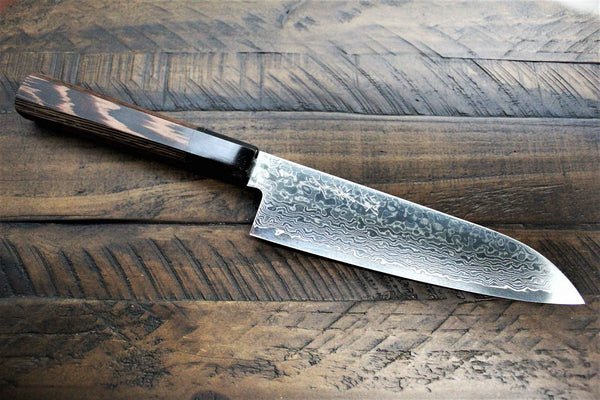
SANTOKU (AKA BUNKA)
The Santoku knife (also known as a Bunka Bōchō) originated in Japan. Santoku means three virtues or three uses. Traditionally, this style of Japanese knife was used most often as a chef’s knife by home cooks. It allows for various cutting methods with a wide range of materials such as meat, fish, and vegetables. It is also useful for slicing cheese, mincing meat, and chopping nuts.
In the U.S., Bunka often refers to a Kengata Santoku, which is the angular, triangle tip rather than the standard hoof tip of most Santoku knives. Many times these also have a flatter edge than traditional Santoku as well.
Ideal for: Precision mincing, dicing and slicing.
This Japanese knife is useful for food types such as small to medium proteins, lettuce, cabbage, kale, carrots, potatoes, squash, cucumber, and eggplant.
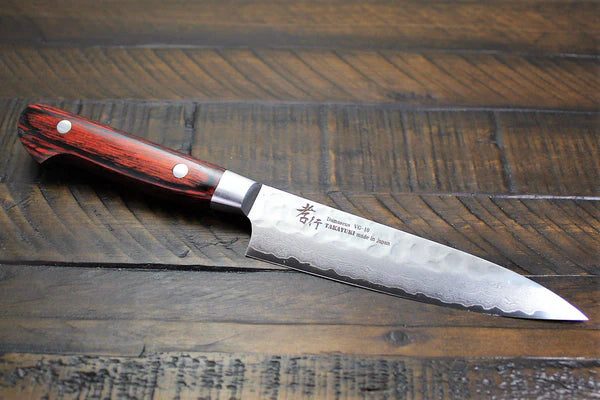
PETTY
The Petty knife is a compact utility knife ideal for small and delicate work that cannot be handled by a larger knife. These knives are great for delicate cutting of small fruits, vegetables, herbs, and boning. It’s also one of the best types of Japanese chef knives for cutting cheeses. Practically speaking, these are one of the first knives you would grab, even for simple things such as cutting up small pieces of chicken.
Ideal for: Slicing, and chopping.
Useful on food types: Small/light proteins, small vegetables such as green beans, green onions, and herbs.

NAKIRI
The Nakiri style of Japanese knives is designed for cutting greens. The blade is double-bevel, thin, and wide while the tip of the blade is flat and square. This Japanese design is mainly for carving vegetables. It is especially useful for shredding vegetables, chopping, or shredding. You can also look at the Usuba for the single-bevel variety of this knife. In Japanese cuisine, this type of knife is specifically useful for cutting vegetables such as daikon or carrot into julienne strips, this method is called “katsura-muki”.
Ideal for: Chopping, slicing, dicing, and mincing.
Useful on food types: All vegetables.
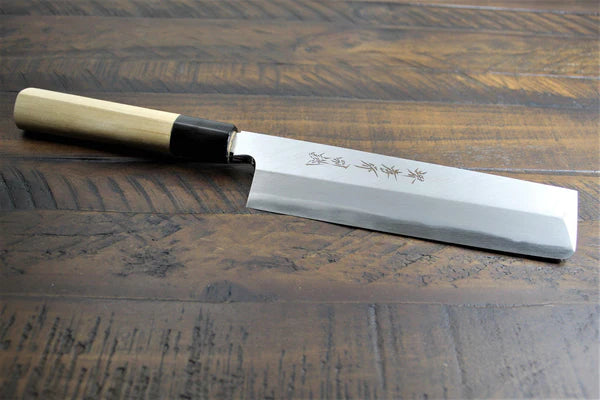
USUBA
These Japanese chef knives are used for vegetables, similar to the Nakiri. This blade originated in the Tokyo region and uses a single-bevel, thin blade. These are used frequently for peeling vegetables, such as the daikon, due to the thin straight single edge. Additionally, as the edge is straight, this type of knife is perfect for rhythmic chopping on a cutting board.
The Usuba is perfect for performing specialized cutting techniques, like Katsuramuki (“rotary peeling”) as well as Kazarigiri (“decorative cutting”).
Ideal for: Chopping, slicing, dicing, and mincing.
Useful on food types: All vegetables. Particularly, peeling Daikon radish.
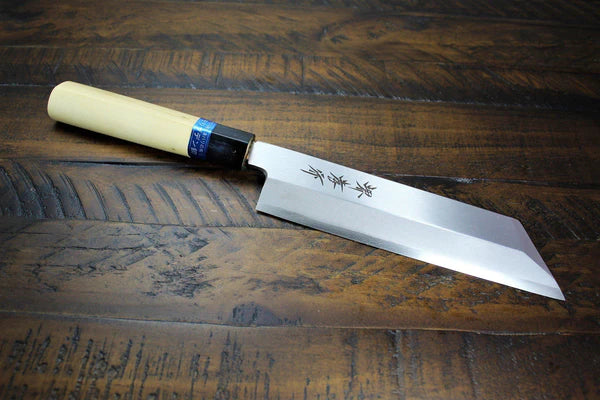
MUKIMONO
This type of Japanese knife allows for stylized, intricate peeling of vegetables. Specifically, when designing peeled artwork to accompany the main dish. The blade is similar to an Usuba in that it is flat and very useful with vegetables. However, the pointed tip allows for precision carving and peeling. This blade is small, thin and lightweight with a single-bevel edge.
Ideal for: Slicing, dicing, mincing, and peeling.
Useful on food types: All vegetables and fruits, specifically when creating artful designs or presentations where precision edge work is needed.
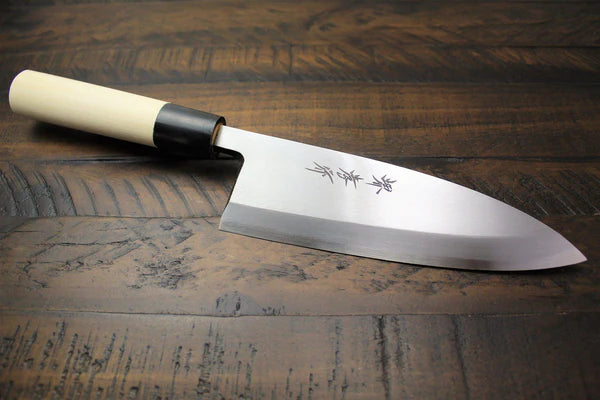
DEBA / AJIKIRI
Deba means a pointed carving knife. The Deba knives originated in Sakai, Osaka during the Edo period. This type of Japanese knife is used for cleaning and cutting fish and birds. The blade has an increased thickness along the spine, and often a more dull angle behind the heel, allowing it to cut off the heads of fish or through bones without damage when used properly. The Deba should not be used to cut through thick bones, however.
The Ajikiri is a smaller, thinner version of the Deba designed for smaller fish such as mackerel.
Ideal for: Slicing and disjointing.
Useful on food types: Breaking down whole fish, meat and poultry where a heavy blade is useful.
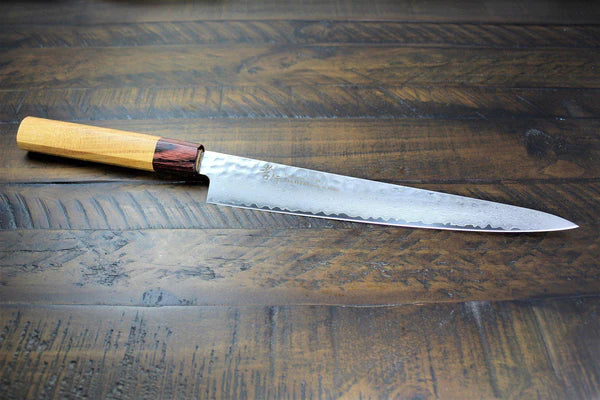
SUJIHIKI
The Sujihiki blade is characterized by its narrow width and short height. These dimensions allow for less contact and friction across the surface area when slicing through meat. This lets you slice through delicate fish in a single clean stroke, excellent for preparing sashimi. This Japanese knife type is also useful for large pieces of poultry meat. The blade is characterized by its double-beveled edges.
Ideal for: Slicing
Useful on food types: Slicing fish filets, carving roasts such as top sirloin, tri-tip or poultry like turkey.
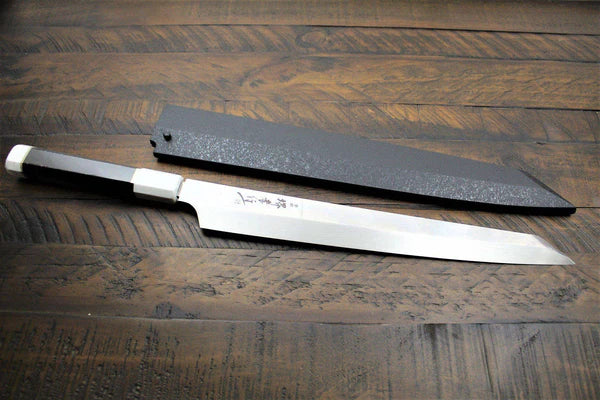
YANAGIBA
Eastern Japan, specifically the Tokyo region, uses the name Yanagiba for this type of Japanese cooking knife, which literally means Willow Leaf. To the west in the Osaka and Kyoto regions, these knives are known as the Shobu. The knife has a slim blade, somewhat similar to a Katana (sword), and is suitable for slicing tasks. The style of Japanese knife is well known as a great sashimi knife, with a single-beveled edge good for cutting and fileting fish. It's pointed and easy to use, making it possible to cut beautiful sashimi just by pulling in a single motion without moving the kitchen knife back and forth.
Ideal for: Slicing
Useful on food types: Slicing fish filets, squid, octopus, other seafood.
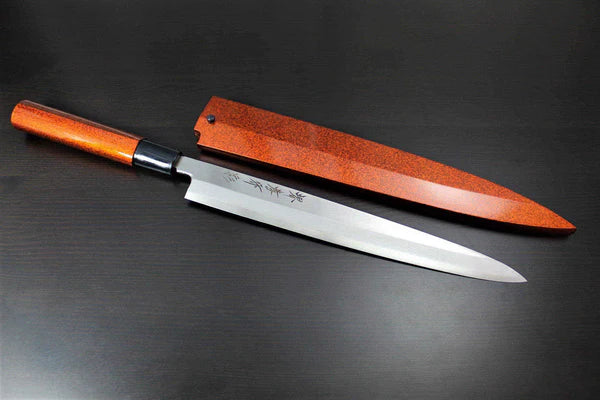
YANAGIBA (SHOBU / TAKOHIKI)
Shobu is the name for the Yanagiba in the Western Japan regions of Osaka and Kyoto; the name literally means Iris Leaf.
Takohiki is similar in purpose to the Yanagiba/Shobu but with a square tip. This type of Japanese knife is more commonly found in the Tokyo region.
According to legend, Takohiki was a square-shaped tipped sushi maker in the Edo period, who was reprimanded for pointing the tip of a knife towards the customer. Interestingly, the tradition of not directing sharp cutting knives to customers still remains, and Takohiki is still favored in Tokyo.
Ideal for: Slicing
Useful on food types: Slicing fish filets, squid, octopus, other seafood.
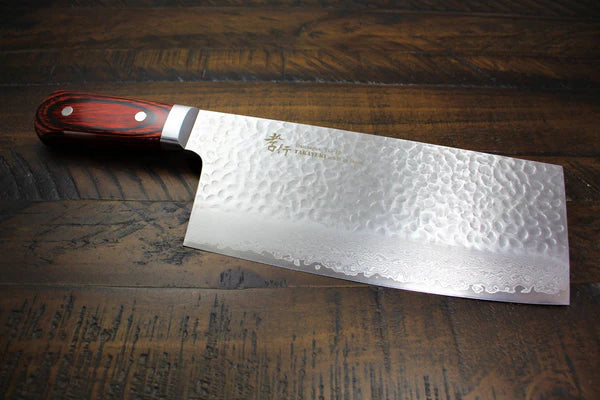
CLEAVER
Chinese cleavers have a thicker blade and are more suited to chopping or breaking apart meat and bones. On the other hand, Japanese-style cleaver knives are ideal for slicing and disjointing. This knife features a heavy blade and is useful for tasks like breaking down whole fish, meat, and poultry.
Ideal for: Chopping, pounding, mincing, slicing, and dicing.
Useful on food types: Vegetables and all size proteins.
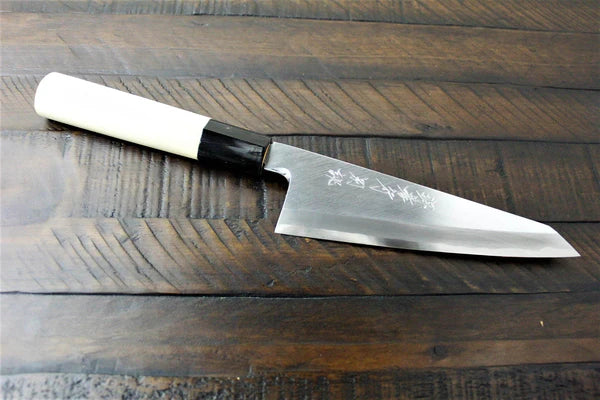
BONING
Honesuki are a type of Japanese boning knife, perfect for deboning whole animals. Typically these knives have a thicker spine than most Western-style boning knives. This allows you to cut through cartilage, while not as thick as a Deba in the spine they are similar to the Deba, wherethe sharp drop tip can be used for the fine slicing.
Ideal for: Boning and removing skin.
Useful on food types: Meat, fish, and poultry.
JAPANESE-STYLE KNIVES VERSUS WESTERN-STYLE KNIVES
Non-Japanese knives have a V-type 'double-edged' structure with a symmetrical blade cross-section. Many Japanese knives are based on a single-edged structure. The back is a flat surface. Only the front side has an oblique grinding surface, and when looking at the cutting edge from the side, the section looks like "レ."
Compared to the Western double-edged version, single-edged knives make it easy to remove the blade when cutting food. This allows for a chef to quickly perform operations such as carving and stripping. The type of motion to use when cutting with a Japanese knife is generally a sliding motion, rather than pushing down. This helps to use the sharpness of the blade.
Low grade kitchen knives create rough surfaces on the items they cut, this is because it cuts the cells and it starts to oxidize quickly. Meanwhile, a sharp knife or handmade Japanese knives will not cut unnecessary cells and will improve the texture and taste. This allows the sliced food to last longer before going bad. Additionally, with the quality of the steel, the sharpness hardly falls even if you keep using it.
HOW TO CHOOSE A HIGH-QUALITY JAPANESE KNIFE
When it comes to cooking, having a reliable knife is essential for precision, ease, and safety. However, choosing the right one can be overwhelming with so many available brands and types, including handmade Japanese knives.
Here, we'll provide you with some tips on how to choose a high-quality Japanese knife that will elevate your cooking experience.
BLADE MATERIAL
The blade material is a critical consideration when choosing a Japanese knife. The most common types of materials are stainless steel and carbon steel. Stainless steel blades are easier to maintain and resist rust, while carbon steel blades are harder and will hold a sharper edge for longer.
HANDLE
The handle of your knife should be comfortable and ergonomic, providing a good grip and balance. Choose a handle that feels comfortable in your hand and complements the blade's weight and size. Handles can be made from various materials, such as wood, plastic, or composite materials.
MATCH YOUR JAPANESE KNIFE TO YOUR COOKING STYLE
Different types of Japanese knives are designed for specific purposes, and choosing the right one can make a significant difference to your cooking experience. For example, if you often prepare from whole fish or meat, a Deba knife may be a good choice, as its thick, heavy blade is ideal for fileting fish and preparing meat. On the other hand, if you frequently chop vegetables, a Gyuto or Santoku may be a better type of Japanese knife. Generally, they are all versatile all-purpose knives that can be used for slicing, dicing, and chopping in addition to working with fish or meat.
Consider your cutting technique as well. Some chefs prefer a rocking motion when chopping, while others use a more traditional pull slicing technique. Japanese knives are designed with different blade shapes to accommodate various cutting techniques. For example, a Gyuto knife has a slightly curved edge ideal for rocking back and forth, while a Yanagiba knife has a straight blade, perfect for slicing with a pulling motion.
Take the time to research and choose the type of Japanese cooking knife that suits your cooking style, needs, and preferences. Doing this will deliver an enhanced cooking experience for years to come.
